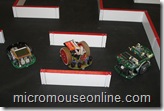Decimus performance graphs
Time to do some tuning of the motion control parameters in Decimus. First I wanted to get some idea of how it is behaving with the initial settings. I have added a simple flight recorder function. A 4 kB buffer can hold up to 2000 integers. These are placed in the buffer on every timer tick. Thus I can record one second of two integers. this isn’t much but it is all I have available on the processor. Any future mouse will have to have a bigger data buffer.

